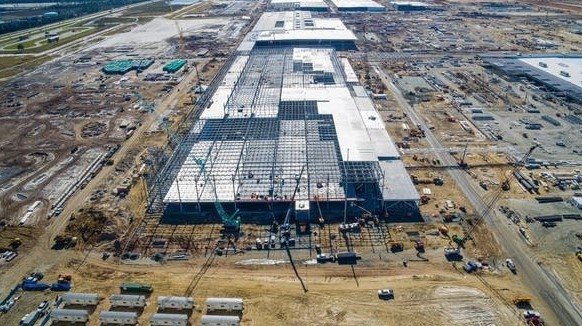A construction worker was killed Tuesday morning at Hyundai’s EV battery plant near Savannah, marking the third fatality since the massive auto manufacturing project broke ground.
The latest tragedy involved an unsecured load falling from a forklift. It struck and killed a subcontractor’s employee at the HL-GA Battery site, which Hyundai operates jointly with LG Energy Solutions. Authorities responded around 11 a.m., confirming the death shortly after arrival.
This isn’t the first time safety concerns have surfaced at the project — and it may not be the last.
A Second Fatality in Two Months Shakes the Site
Just weeks ago, on March 21, a horrifying scene unfolded when 57-year-old Sunbok You was hit and dragged by a forklift. His body was severed at the waist, and he died at the scene.
Two fatal accidents in two months. It’s not a statistic — it’s a crisis. And workers on the site know it.
Many laborers, speaking anonymously, say safety briefings are held regularly but aren’t always followed through on the ground. “People are scared,” one construction worker admitted. “We talk about safety a lot, but these accidents keep happening. That says something’s broken.”
So far, Hyundai hasn’t provided specifics about the identity of the latest victim. What we know is that he wasn’t a Hyundai employee directly — he worked for a subcontractor. Still, the tragedy is no less devastating.

How Big Is This Project—and Its Risk?
The HL-GA Battery plant sits on a staggering 3,000-acre stretch of land in Bryan County. It’s part of Hyundai’s $5.5 billion investment in electric vehicle manufacturing in Georgia, a cornerstone of the state’s economic development push.
Construction began in 2022 and is set to wrap up in 2025. When complete, the site is expected to create more than 8,000 jobs, producing hundreds of thousands of EVs and batteries each year.
But building something that big comes with enormous risk — and the numbers speak for themselves:
-
3 worker deaths since construction began.
-
1 serious injury (a broken arm from a fall in March).
-
Thousands of workers on-site daily.
Construction is inherently dangerous. Still, for a marquee project drawing billions in investment and political praise, these incidents are ringing alarm bells.
Forklifts and Fatalities: A Growing Pattern?
Here’s what’s especially troubling: two of the three worker deaths at the site involved forklifts.
In one case, a forklift hit and dragged a man, killing him. In the latest, an unsecured load from a forklift fell and crushed another. That’s a pattern — and not a good one.
Forklift-related deaths are sadly common in the construction industry. According to OSHA, about 85 workers die annually in the U.S. from forklift-related accidents.
So the question becomes: why are these machines becoming killers at a site that’s supposed to represent the future of green technology?
One local safety inspector, who declined to be named, said, “It’s possible the scale of this project has overwhelmed existing oversight. Forklifts should be operated by trained, certified staff. If corners are being cut, it’s a matter of time before tragedy strikes.”
Worker Sentiment on the Ground Is Wavering
For many on-site, morale is slipping.
Some workers say the atmosphere has changed since March. More guards. More walk-throughs. More hush-hush meetings. But fewer answers.
One longtime foreman said, “You can’t bring in thousands of workers, throw them on a high-pressure job, and expect zero incidents. But three deaths? That’s not acceptable.”
Others pointed to subcontractor issues. Many teams on the Hyundai site are third-party — electricians, steelworkers, operators — often with their own safety policies. Coordination is complex and sometimes messy.
What Hyundai Is Saying — and Not Saying
Michael Stewart, Hyundai’s public relations head in the U.S., released a carefully worded statement Tuesday afternoon. It emphasized condolences, a commitment to safety, and cooperation with authorities.
But it didn’t offer much else.
There were no specifics about what went wrong. No updates on potential disciplinary actions. No mention of whether operations were paused following the death.
To others — especially grieving coworkers — it’s cold comfort.
Safety Measures and Oversight: What Needs to Change?
Let’s break down where things might be going wrong. OSHA compliance is required, yes. But this is a megaproject — multiple contractors, high turnover, language barriers, pressure to meet deadlines.
The Georgia Department of Labor is now under pressure to step up inspections. So far, there’s no word on whether they’ll issue citations or fines.
Construction experts say more proactive monitoring could help. Random audits. Unannounced inspections. Anonymous whistleblower protections. It’s not just about reacting after a death — it’s about preventing one.
Bigger Than Hyundai: What This Means for Georgia’s Green Push
Georgia Governor Brian Kemp has staked much of his legacy on transforming the state into a southern EV powerhouse. Hyundai is the crown jewel of that effort.
So these accidents don’t just hit families — they hit politics, too.
As the state races to out-compete rivals like Texas and North Carolina for clean-tech investment, safety lapses like these could derail momentum. Investors, regulators, and even consumers are watching closely.
